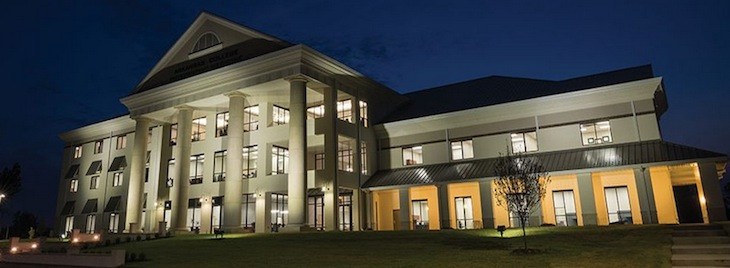Medical college economic impact valued at $415 million, more with physician retention
by June 5, 2018 6:22 pm 2,340 views

An economic impact study suggests the Arkansas Colleges of Health Education (ACHE) will produce at least a $415 million boost to the Fort Smith metro. But ACHE President and CEO Kyle Parker believes keeping graduating medical students in the region is the key to creating an even larger impact.
HISTECON Associates and the University of Arkansas at Little Rock Economic Development Institute recently completed the $16,000 economic impact report. Arvest Bank and First National Bank of Fort Smith paid for the report which provided impact analysis on payroll and operations, current and future construction projects, student and faculty local spending, and visitor spending.
ACHE and the college was founded with primary support from The Degen Foundation, a Fort Smith-based philanthropy created with some of the revenue from the 2009 sale of Sparks Health System to then Naples, Fla.-based Health Management Associates. Work began in February 2015 on the $32.4 million facility in east Fort Smith in the Chaffee Crossing area. The school opened in August 2017 and is housed in the three story, 102,000-square-foot building. A fully operational osteopathic college is expected to serve about 600 students when all four classes are full.
ACHE recently broke ground on an adjacent 66,000-square-foot College of Health Sciences expected to open in 2020. The college will offer graduate level programs in physician assistant studies, physical therapy, and occupational therapy. Based on the latest construction bids, the total building and equipment cost will approach $18 million.
DEMAND, INCOME GROWTH
According to the report, “Spending and re-spending of new direct and indirect income will inevitably radiate to other neighboring market areas as well as remain in the Fort Smith MSA.”
The direct and indirect spending primarily comes from employment by businesses that provide goods and services to ACHE, and the addition of new demand for goods and services resulting from more incomes and increased incomes.
“The spending or investing of this increment will motivate more economic activity in the region, creating more jobs,” noted the UALR report.
Following are other report findings.
• ACHE medical student’s spending will grow from about $4 million currently to more than $13 million when full enrollment occurs in 2021.
• From 2018-2022 the effects of spending on operations, payroll, construction projects, the multiplier phenomenon and visitor spending will create a total value-added to the economy of at least $368 million. Student spending will add another $46 million, for a total of almost $415 million added to the economy.
• There will be $17.9 million in new retail sales by 2021.
• Activities and construction related to ACHE projects will create 371 new jobs, plus 366 temporary construction jobs by 2021.
However, the impact is likely to be more than $415 million. What is not included in the report are the 25 new jobs averaging $100,000 that were recently announced, 30 new jobs averaging $100,000 created in the start of the new College of Health Sciences programs once accredited, the 84,000-square-foot Heritage Village project – estimated at $11 million – that will include 28,000 square foot of retail space, and Celebration Park construction costs of $3 million.
“We were moving too fast. They (UALR) couldn’t factor it all in,” Parker told Talk Business & Politics during a Monday (June 4) interview.
‘THE CHALLENGE’
Parker, who presented the report Tuesday night (June ) to the Fort Smith Board of Directors, said regional business and political leaders “have been phenomenal” in support of ACHE. He said that needs to continue in the effort to keep as many of the graduating medical students in the region.
According to the report, each physician who stays in the region creates – through salaries for support staff, equipment, supplies and other related expenses – a $1.8 million economic impact. Based on the graduation cycle, the report noted the following impacts.
• $1.8 Million X 150 Physicians = $270 Million in 2024;
• $1.8 Million X 300 Physicians = $540 Million in 2025;
• $1.8 Million X 450 Physicians = $810 Million in 2026; and
• $1.8 Million X 600 Physicians = $1.08 Billion in 2027.
Parker said it’s not likely the region will keep all 600 doctors, but believes the metro market of western Arkansas and eastern Oklahoma “could easily handle 300 physicians.”
“This is our challenge. This is the key,” Parker said in the Monday interview. “I think we can keep 50% in Arkansas, and in eastern Oklahoma. … But that’s the community challenge to help us make that happen.”
He praised the addition of cultural amenities – The Unexpected, Peacemaker Festival, Steel Horse Rally, addition of bike paths, etc. – in the region, noting that the quality of life “wants, desires and expectations are higher” among ACHE medical students and faculty who come to Fort Smith from all over the country.
“These students participate. They participate and get involved in events, in the arts. They want the music … and the downtown events. That’s really, really important to them,” Parker said.
Parker also said ACHE gives the region an advantage in dealing with the ongoing physician shortage. The American Association of Medical Colleges predicts a shortage of 121,000 physicians by 2030, with rural America being the hardest hit. Between 1987 and 2007 the U.S. population grew by 24%, but the number of trained physicians grew by only 8%. Parker said there is just one primary care doctor for every 6,000 Arkansas residents.
“I just want to say thank you,” City Director Mike Lorenz said at the conclusion of Parker’s presentation to the board.
